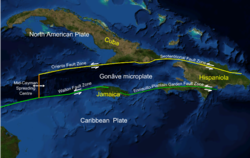Cayman Trough


The Cayman Trough (also known as the Cayman Trench, Bartlett Deep and Bartlett Trough) is a complex transform fault zone pull-apart basin which contains a small spreading ridge, the Mid-Cayman Rise, on the floor of the western Caribbean Sea between Jamaica and the Cayman Islands.[1] It is the deepest point in the Caribbean Sea and forms part of the tectonic boundary between the North American Plate and the Caribbean Plate. It extends from the Windward Passage, going south of the Sierra Maestra of Cuba toward Guatemala. The transform fault continues onshore as the Polochic-Motagua fault system, which consists of the Polochic and Motagua faults.[2] This system continues on until the Chiapas massif where it is part of the diffuse triple junction of the North American, Caribbean and Cocos plates.[3]
The relatively narrow trough trends east-northeast to west-southwest and has a maximum depth of 7,686 metres (25,217 ft). Within the trough is a slowly spreading north–south
During the
In 2010 a
See also
References
- ISBN 978-3-540-66193-1.
- S2CID 3161221.
- .
- ^ .
- .
- ISSN 1096-7451.
- ^ Carpenter, Jennifer (August 9, 2008). "Sub to make deep Caribbean dive". BBC Science News. Retrieved August 9, 2008.
- ^ "World's deepest undersea vents discovered". LiveScience.com. April 11, 2010. Retrieved April 12, 2010.
- ^ "Latest news". RRS James Cook Voyage 44. Retrieved January 14, 2012.
- ^ McGrath, Matt (January 12, 2012). "Cayman vents are world's hottest". BBC News. Retrieved January 14, 2012.
Further reading
- Goreau, P. D. E. 1983 Tectonic Evolution of the North Central Caribbean Plate Margin. Woods Hole Oceanographic Institution, MA.; Massachusetts Inst. of Tech., Cambridge. Sponsor: National Science Foundation, Washington, DC. Sep 1983. 248p. Report: WHOI-83-34.
- Ten Brink, Uri S., et al., 2001, Asymmetric seafloor spreading: crustal thickness variations and transitional crust in Cayman Trough from gravity", GSA Meeting Abstract
- Roberts, H. H. 1994 Reefs and lagoons of Grand Cayman Monographiae biologicae (Brunt, MA; Davies, JE eds). Kluwer Academic Publishers, Boston, Ma The Hague. ISBN 0-7923-2462-5
- Ruellan, E. et al., 2003, Morphology and Tectonics of the Mid-Cayman Spreading Center, EGS - AGU - EUG Joint Assembly, Abstract
- Scotese, Christopher R. 1999. Evolution of the Caribbean Sea (100 mya - Present) Collision of Cuba with Florida Platform and Opening of the Cayman Trough. PALEOMAP Project http://www.scotese.com/caribanim.htm
